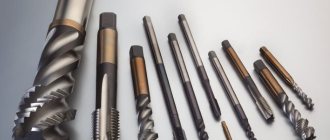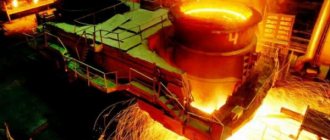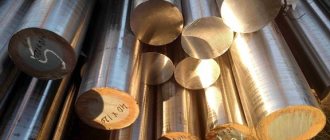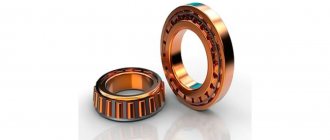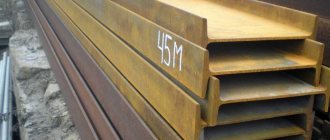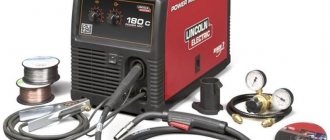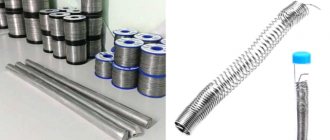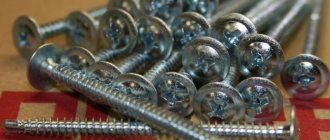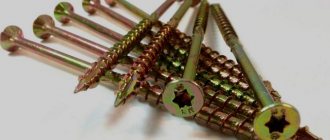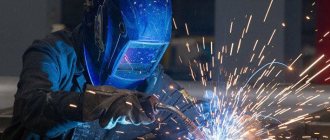Steel classifications
To understand the variety of brands, metallurgists use several classifications:
Steels are classified:
- by chemical composition;
- by structure;
- by appointment;
- by quality;
- according to the degree of deoxidation.
There are other classifications, but their use is limited to scientific and highly specialized areas of application.
Classification by chemical composition
According to the chemical composition, the classification is carried out, dividing into: carbon and alloy steels, which, in turn, are divided into:
| carbon | Carbon content, % |
| < 0,2 | low carbon |
| 0,2–0,45 | medium carbon |
| >0,45 | high carbon |
| alloyed | Additive content,% |
| <2.5 | low alloy |
| 2,5-10 | medium alloyed |
| >10 | highly alloyed |
Carbon content does not affect the degree of alloying. If the proportion of Mn exceeds 1% and Si - 0.9%, they are also recognized as alloying additives
Classification by structure
The structure of steel, in addition to its chemical composition, depends on many factors that influenced it at the stages of casting and heat treatment. The classification by structure after the annealing procedure, during which the workpiece is heated to the plasticity temperature and slowly cooled directly in the furnace, is as follows:
- hypoeutectoid - with excess ferrite inclusions;
- eutectoid - ferrites are replaced by pearlites;
- hypereutectoid - with inclusions of secondary carbides;
- ledeburite - with inclusions of primary carbides;
- austenitic;
- ferritic.
Microstructure of ledeburite steel
Eutectoid steel and its microstructure
After carrying out the normalization procedure, which consists of heating to the plasticity temperature and cooling in the open air, the classification distinguishes groups such as:
- pearlite;
- austenitic;
- ferritic.
Microstructure of perlite
Classification by degree of deoxidation
The deoxidation process leads to a decrease in the oxygen content in the melt. The classification includes classes such as:
- calm (sp);
- semi-calm (ps);
- boiling (kp).
The main deoxidizing additives are Mn, Al, Si.
Classification of steels by degree of deoxidation
Microstructure
In a normalized state, steels are:
- pearlitic - characterized by a low content of alloying elements and, after normalization, have the structure: pearlite, pearlite + ferrite, pearlite + hypereutectoid carbide;
- martensitic - have a reduced critical hardening rate and a fairly high content of alloying elements;
- austenitic - increased content of alloying elements, under the influence of which the structure is achieved: austenite, austenite + carbide.
Classification of carbon steels in the annealed state:
- hypoeutectoid is used, for example, for hot deformation dies;
- hypereutectoid has a structure consisting of pearlite and cementite, usually used for making tools;
- carbide (ledeburite) - for example, high-speed steel;
- ferritic - stainless, heat-resistant, heat-resistant, high-chromium steel.
Classification of steel by impurity content
In addition to classification by carbon content and degree of deoxidation, classification is used by quality, determined by the production method and the content of harmful impurities, primarily sulfur and phosphorus. Classification of steels by quality:
| Group | Sulfur,% | Phosphorus, % |
| Ordinary (ordinary) | < 0,06 | < 0,07 |
| Quality | < 0,04 | < 0,035 |
| High quality | < 0,025 | < 0,025 |
| Particularly high quality | < 0,015 | < 0,025 |
In some classifications, especially high-quality ones are included in the composition of high-quality ones.
Ordinary quality
The majority of ordinary steels are carbon alloys (C < 0.6%). They are produced by the open-hearth method or by the converter method using oxygen. These types of steel are intended for the most widespread applications, are inexpensive to produce, can be easily processed, but do not have particular strength or wear resistance.
Quality
High-quality ones include both carbon and alloyed ones. They are also produced by the open-hearth or converter method with oxygen blast, but the composition of the raw materials is subject to much more stringent requirements than in the case of ordinary ones. The requirements for compliance with melting and bottling parameters are also stricter. Such groups of steels are more expensive and are used for more critical parts operating under severe loads.
Classification of steels by quality
High quality
This group is produced by more technologically advanced methods, such as smelting in electric furnaces. Features of the production technology make it possible to achieve a particularly low content of harmful impurities of non-metals and gas inclusions, which guarantees high mechanical properties. Such steels are used in particularly critical components, and their cost is several times higher than conventional ones.
High strength steel
Particularly high quality
They complete the classification of steels by quality. They are produced by melting using the electroslag method, which makes it possible to reduce the impurity content several times. Some grades are close in price to precious metals, and such alloy steels are used in unique cases - in parts of nuclear reactors, cryogenic installations, the defense and aerospace industries, and some others.
Deoxidation
There is also a classification of steels depending on the degree of deoxidation, that is, on how much oxygen was removed during the manufacturing process. Based on this parameter, steels are:
- boiling - slightly deoxidized, saturated with oxygen;
- calm - completely deoxidized;
- semi-quiet - steels in which oxygen has been partially removed.
Aluminum, manganese and silicon are used for deoxidation of low-carbon steels. Boiling steel is usually deoxidized with ferromanganese into semi-quiet steel; in addition, a small amount of ferrosilicon is added, and the calm steel, in addition to the previous components, is treated with aluminum and silicomanganese.
Classification of steel by purpose
The following type of steel classification is by purpose:
- structural;
- instrumental;
- with special physical and chemical characteristics.
This classification is quite arbitrary; one group may contain dozens of brands, while another may contain one or two.
Classification of steels by purpose
In addition, many brands, due to their mechanical properties, are also suitable for related purposes. When choosing a brand for a specific design or part, designers and technologists take into account, in addition to the formal purpose, many more factors, such as price, machinability, compatibility with other parts in terms of the coefficient of thermal expansion, and others. Sometimes the designer uses a brand that is obviously superior in its parameters and cost to a simple structural grade that is quite suitable for a given part. This is acceptable in conditions of unique production or especially small series, high transport costs, and a number of other cases. Any such decision must be justified from a financial point of view.
Structural
Structural steels of ordinary quality represent one of the most extensive groups.
Structural steel
The classification provides:
- construction;
- cold stamping;
- cemented;
- improved;
- high strength;
- spring-spring;
- bearing;
- automatic;
- corrosion resistant;
- wear-resistant;
- heat resistant and heat resistant.
Construction
This includes a large number of grades of ordinary carbon and low alloy alloys. Such materials are used to create complex spatial structures in which the load is evenly distributed between all elements. There are no special requirements for each of them, other than good weldability.
For cold stamping
During cold stamping, the shape of the workpiece and its dimensions change significantly, therefore, for this group of low-carbon high-quality alloys, the main requirement is different - high ductility and tensile strength.
Cementable
This group is used for the production of units and parts subject to friction and variable periodic loads. The cementation procedure serves to increase the surface's resistance to wear. It includes low-carbon (0.1-0.3%) and some alloyed alloys.
Case-hardened steel products
Upgradeable
These grades are intended for special types of heat treatment, such as hardening and tempering, used to improve the strength and other mechanical characteristics of the material. The group includes both medium carbon and chromium, including those with additives of boron, manganese, nickel and molybdenum.
High strength
For high-strength, medium-carbon, high-alloy alloys, the composition and ratio of additives, as well as specific heat treatment programs, are specially selected. As a result, metallurgists achieve strength characteristics that are two or more times greater than those of structural grades. They are used in particularly critical units.
Spring
The main feature of spring spring brands is the ability to undergo repeated elastic deformations without accumulating the effect of fatigue. They are very widely used in transport and mechanical engineering, wherever depreciation, damping of vibrations or ensuring the return of parts of the mechanism to their original position after performing a working movement is required. To increase the elastic limit, carbon alloys are alloyed with silicon, manganese, boron and other elements.
Spring steel
Bearing
To ensure the required service life of engines, machine tools and other mechanisms that use bearings, products made from alloys of this group must be high-strength, wear-resistant and durable. Foreign inclusions, inhomogeneities, and all types of pores should be minimized. Contains about one percent carbon and 0.8-1.5% chromium, subject to special compaction and heat treatment
Automatic
The main parameter for alloys of this group is high machinability, the formation of easily breaking short chips and reduced friction between the part and the tool. They are used for the production of mass series of fastening components on automated production complexes. Sulfur, lead, selenium and tellurium are added to the composition. The downside is the reduced ductility of the material.
Wear-resistant
By adding large quantities of manganese to the alloy, wear-resistant steel grades are obtained. Their purpose is the production of units subject to strong friction, including abrasive, and large static and dynamic loads. These are elements of switches on the rail track, mining equipment, loader buckets, and tracks.
Damper made of wear-resistant steel
Corrosion resistant stainless steel
These low-carbon alloys are heavily alloyed with chromium and manganese. During crystallization, chromium forms a thin surface layer of oxides that protects the part from exposure to chemically active environments. Such alloys can be used in both mildly aggressive (water, steam) and highly aggressive environments (solutions of acids, alkalis, sea water) at temperatures up to 60 °C
The corrosion-resistant group has its own classification
- Corrosion resistant. They are used to make shafts, springs, valves, and turbine blades that can withstand high loads and up to 600 °C.
- Heat resistant. Designed to operate at high temperatures (up to 1200 °C) under limited loads.
- Heat resistant. Low-carbon alloys highly alloyed with nickel, silicon and other additives can operate under conditions of both high temperatures (up to 75% of the melting point) and high loads.
- Cryogenic. Maintain elasticity and viscosity at low and especially low temperatures (down to -200 °C). They are used for the manufacture of components for industrial and scientific refrigeration units.
In their properties, these materials differ significantly from the well-known food grade stainless steel, from which dishes and kitchen equipment are made.
Steels with special chemical and physical properties
In addition to all of the above, there are also steel grades with special properties:
- electrical steel - an alloy of iron and silicon, sometimes alloyed with aluminum; used in the production of magnetic circuits for various electrical equipment;
- superinvar is an alloy of iron, nickel and cobalt used in the manufacture of high-precision equipment;
- heat-resistant - has increased resistance to destruction at temperatures above 900 °C, alloyed with aluminum, silicon, nickel;
- heat-resistant - used for the manufacture of parts for gas turbine units; such steels are designed to work under load at high temperatures for some time.
Tool steels
Materials from a large and diverse group of tool brands are subject to specific requirements related to the specific application of the products made from them. The group also has its own subgroups. The main ones are alloys for:
- cutting tools;
- measuring instruments;
- stamped;
- roller
For cutting tools
The main requirement for alloys of this group is the ability to maintain a given hardness, strength and heat resistance under prolonged mechanical and thermal loads.
Tool steel tool for cutting tools
Such alloys are very expensive, so cutting tools, as a rule, are not made entirely of tool materials, but use cutting plates or surfaces of other shapes, fused or fixed on a base made of structural grades. This allows you to significantly reduce the cost and extend the service life of the tool.
The group is also divided into:
- Carbon tool alloys. They contain from 0.5 to 1.3% carbon. Suitable for common cutting tools for mass use.
- Alloyed instrumental. To increase strength and heat resistance (up to 300 °C), alloying additives are used - chromium, vanadium and others from 1 to 3%. Drills, cutters and broaches are made from such materials.
- High-speed cutting. They are used for highly efficient progressive tools with high heat resistance - up to 660 °C.
The high cost of a progressive tool is more than compensated in the general case by increasing equipment productivity, reducing wear on machines per product, reducing labor intensity and increasing the rate of product production. The economic effect depends on the size of the series.
Steels for measuring instruments
The main requirement for materials in this group is stability of shape and size during measurement and storage.
Steel product for measuring instruments
The second most important property is the exceptional surface quality, good machinability and especially sandability. Of course, the requirements for wear resistance and hardness also remain in force. Both inexpensive carbon grades and those alloyed with chromium, nickel and other additives are used. Products are subjected to carburization and hardening to improve surface quality and increase wear resistance. Recently, with the development of advanced non-contact methods and measuring instruments, such as laser, ultrasonic and hardware-software integrated into machining centers, the need for alloys of this group has decreased somewhat. But they are still in demand both in pilot production and in the manufacture and verification of those very progressive measuring instruments.
Die steels
Alloys of this group must be particularly hard, hardenable and heat resistant. The main requirement for them is high wear resistance and constancy of the product’s shape. This includes alloys:
- Cold stamping. To the basic requirements - hardness, wear resistance, stability of shape and dimensions - are added heat resistance and high viscosity, since the products operate under conditions of high pressure and shock. They are made on the basis of chromium-containing alloys with the addition of other elements. Many varieties are interchangeable with high-speed ones.
- Hot stamping. The requirements for cold-formed alloys include increased strength and toughness at high temperatures (up to 500 °C) and high thermal conductivity to avoid overheating. Alloyed with high contents of chromium, vanadium, nickel, etc.
Roll steels
They are used for the manufacture of various rolls of rolling mills, knives for cutting metal, dies and punches. They are also used for the manufacture of unique highly loaded components of paper-making and mining equipment.
Roll steel
The following requirements are put forward to them:
- High hardenability to achieve the required strength throughout the entire part, sometimes reaching tens of meters. In this case, hardening is carried out with a slow cooling schedule in oil.
- Deep hardenability. To ensure consistency in the size and shape of the rolled product produced, it is important that the high-strength zone is not concentrated in the surface layer, but evenly penetrates the entire volume of the product, reaching a diameter of several meters, guaranteeing the specified rigidity of the entire roll. This is achieved by bringing carbon to 0.8%, special selection of alloys (including silicon and boron) and careful adherence to the heat treatment program, especially in terms of the cooling schedule.
- High wear resistance. Guarantees long-term uninterrupted operation of the entire rolling mill, stability of rolling parameters and reduced costs for unscheduled repairs and subsequent adjustment of equipment.
- Sufficient contact strength. The value of the parameter with a given margin must exceed the stresses arising during the technological process, taking into account both the loads from the weight of the equipment itself and those arising due to the resistance of the rolled material.
- Minimization of own deformations, misalignment and warping during heat treatment, as well as the maximum possible stability of the shape and dimensions of the product during its operation.
The list of requirements ends with acceptable machinability of products and excellent grindability and polishability of surfaces. This will allow us to obtain consistently high quality rolled products.
Alloy production
The process of manufacturing the alloy comes down to the processing of cast iron, during which excess impurities are annealed and alloying elements are introduced. Several methods are used for this.
- Open-hearth - molten or solid cast iron with ore is smelted in an open-hearth furnace at 2000 C to anneal off excess carbon. Additives are introduced at the end of the melt. The steel is poured into ladles and transported to the rolling mill.
- Oxygen converter – more productive. Air or a mixture of air and oxygen is blown through the cast iron in the furnace, achieving faster and more complete annealing.
- Electric melting - melting is carried out in a closed furnace at 2200 C, which prevents gases from entering the alloy. An expensive method that only produces high-quality compounds.
- Direct method - in a shaft furnace, pellets obtained from iron ore are blown with combustion products of natural gas - a mixture of oxygen, carbon monoxide, ammonia, at a temperature of 1000 C.
The steel making process does not end there. In cases where it is necessary to obtain the most durable material, additional processing is resorted to.
Thermal method
Thermal methods include:
- annealing – heating and slow cooling of different types and at different speeds;
- hardening - heating above the critical temperature, which causes recrystallization of the alloy, and faster cooling;
- tempering is a procedure carried out after hardening in order to reduce the stress of the metal;
- normalization is the same annealing, but carried out not in an oven, but in air.
Thermo-mechanical method
Thermomechanical methods combine mechanical and thermal effects:
- high-temperature TMT - hardening - hardening, hardening, is carried out immediately after heating, while the alloy retains its austenitic structure. The change due to plastic deformation during rolling or stamping is retained by 70% and after cooling the steel turns out to be stronger;
- for low-temperature TMT – cold-rolled steel. The alloy is heated to achieve an austenitic state, cooled below the recrystallization points to achieve the appearance of a martensitic phase - within 400–600 C. Then hardening is carried out - hardening, rolling. When cooled, the effect is completely preserved.
Thermochemical treatment
Thermochemical treatment is the heating of alloys and holding them in certain chemical environments. The most well-known methods include:
- carburization – saturation of the alloy surface with carbon. In this way a wear-resistant top layer is obtained;
- nitriding – saturation of steel with nitrogen. The goal is the same - to obtain a top wear-resistant layer, but compared to carburization, nitriding provides higher corrosion resistance;
- nitrocarburization and cyanidation - saturation of the surface layer with both carbon and nitrogen. Provides higher speed and productivity of the process.
